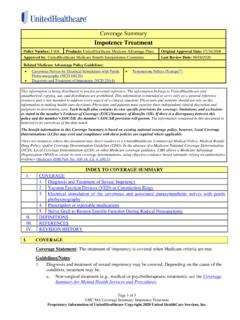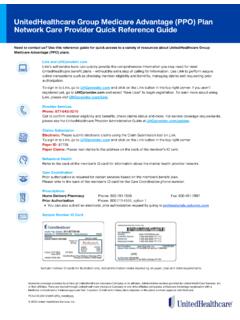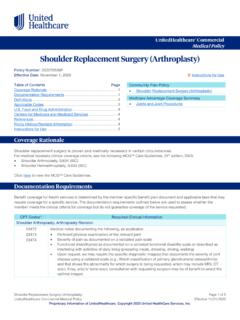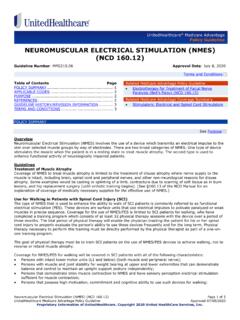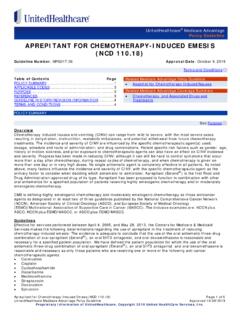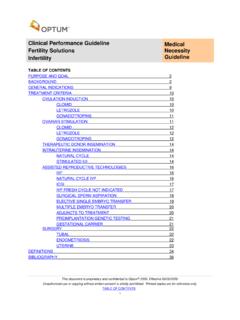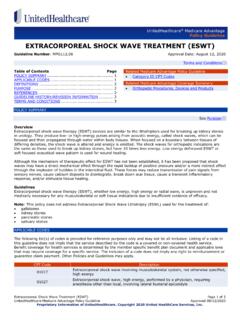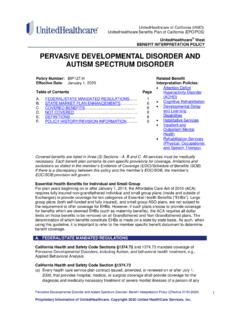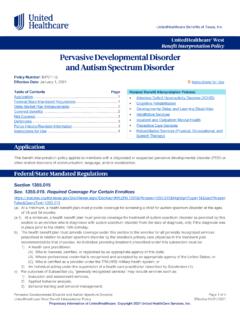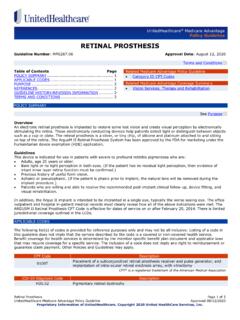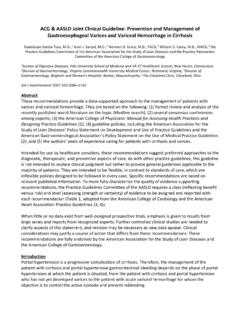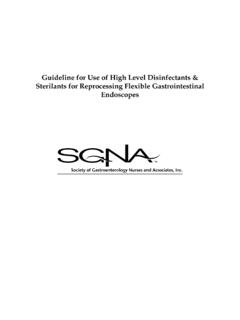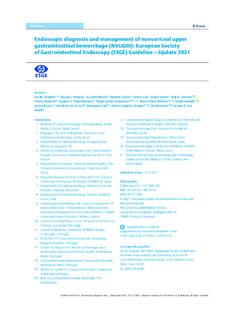Transcription of Bariatric Surgery – Community Plan Medical Policy
1 Bariatric Surgery Page 1 of 64 UnitedHealthcare Community Plan Medical Policy Effective 01/01/2021 Proprietary Information of UnitedHealthcare. Copyright 2021 United HealthCare Services, Inc. UnitedHealthcare Community Plan Medica l Policy Bariatric Surgery Policy Number: Effective Date: January 1, 2021 Instructions for Use Table of Contents Page Application .. 1 Coverage Rationale .. 1 Definitions .. 3 Applicable Codes .. 4 Description of Services .. 5 Clinical Evidence .. 9 Food and Drug Administration .. 51 References .. 52 Policy History/Revision Information .. 63 Instructions for Use .. 64 Application This Medical Policy does not apply to the states listed below; refer to the state-specific Policy /guideline, if noted: State Policy /Guideline Indiana Bariatric Surgery (for Indiana Only) Kentucky Bariatric Surgery (for Kentucky Only) Louisiana Bariatric Surgery (for Louisiana Only) Mississippi Bariatric Surgery (for Mississippi Only) Nebraska Bariatric Surgery (for Nebraska Only) New Jersey Bariatric Surgery (for New Jersey Only) North Carolina Bariatric Surgery (for North Carolina Only) Pennsylvania Bariatric Surgery (for Pennsylvania Only) Tennessee Bariatric Surgery (for Tennessee Only) Coverage Rationale The following Bariatric surgical procedures are proven and medically necessary for treating obesity.
2 Biliopancreatic bypass/biliopancreatic diversion with duodenal switch Gastric bypass (includes robotic-assisted gastric bypass) Laparoscopic adjustable gastric banding for individuals 18 years of age (refer to the Food and Drug Administration (FDA) section for additional information) Sleeve gastrectomy (vertical sleeve gastrectomy) Vertical banded gastroplasty Related Community Plan Policies Minimally Invasive Procedures for Gastroesophageal Reflux Disease (GERD) and Achalasia Obstructive Sleep Apnea Treatment Robotic-Assisted Surgery Policy Commercial Policy Bariatric Surgery Medicare Advantage Coverage Summary Obesity: Treatment of Obesity, Non-Surgical and Surgical ( Bariatric Surgery ) Bariatric Surgery Page 2 of 64 UnitedHealthcare Community Plan Medical Policy Effective 01/01/2021 Proprietary Information of UnitedHealthcare. Copyright 2021 United HealthCare Services, Inc. In adults, Bariatric Surgery using one of the procedures identified above for treating obesity is proven and medically necessary when all of the following criteria are met: Class III Obesity; or Class II Obesity in the presence of one or more of the following co-morbidities: o Type 2 diabetes; or o Cardiovascular disease [ , stroke, myocardial infarction, poorly controlled hypertension (systolic blood pressure greater than 140 mm Hg or diastolic blood pressure 90 mm Hg or greater, despite pharmacotherapy)]; or o History of coronary artery disease with a surgical intervention such as coronary artery bypass or percutaneous transluminal coronary angioplasty; or o History of cardiomyopathy.
3 Or o Obstructive Sleep Apnea (OSA) confirmed on polysomnography with an AHI or RDI of 30 and The individual must also meet the following criteria: o Both of the following: Completion of a preoperative evaluation that includes a detailed weight history along with dietary and physical activity patterns; and Psychosocial-behavioral evaluation by an individual who is professionally recognized as part of a behavioral health discipline to provide screening and identification of risk factors or potential postoperative challenges that may contribute to a poor postoperative outcome or o Participation in a multi-disciplinary surgical preparatory regimen In Adolescents, the Bariatric surgical procedures identified above are proven and medically necessary for treating obesity when all of the following criteria are met: Class III Obesity; or Class II Obesity in the presence of one or more of the following co-morbidities: o Type 2 diabetes; or o Cardiovascular disease [ , stroke, myocardial infarction, poorly controlled hypertension (systolic blood pressure greater than 140 mm Hg or diastolic blood pressure 90 mm Hg or greater, despite pharmacotherapy)]; or o History of coronary artery disease with a surgical intervention such as coronary artery bypass or percutaneous transluminal coronary angioplasty; or o History of cardiomyopathy; or o Obstructive Sleep Apnea confirmed on polysomnography with an AHI or RDI of 30 and The individual must also receive an evaluation at, or in consultation with, a multidisciplinary center focused on the surgical treatment of severe childhood obesity.
4 This may include adolescent centers that have received accreditation by the Metabolic and Bariatric Surgery Accreditation and Quality Improvement Program (MBSAQIP) or can demonstrate similar programmatic components. Revisional Bariatric Surgery using one of the procedures identified above is proven and medically necessary when due to a Technical Failure or Major Complication from the initial Bariatric procedure. The following procedures are unproven and not medically necessary for treating obesity due to insufficient evidence of efficacy: Revisional Bariatric Surgery for any other indication than those listed above Bariatric Surgery as the primary treatment for any condition other than obesity Bariatric surgical interventions for the treatment of obesity including but not limited to: o Bariatric artery embolization (BAE) o Gastric electrical stimulation with an implantable gastric stimulator (IGS) o Intragastric balloon o Laparoscopic greater curvature plication, also known as total gastric vertical plication o Mini-gastric bypass (MGB)/laparoscopic mini-gastric bypass (LMGBP) o Single-anastomosis duodenal switch (also known as duodenal switch with single anastomosis, or stomach intestinal pylorus sparing Surgery [SIPS]) o Stomach aspiration therapy (AspireAssist ) Bariatric Surgery Page 3 of 64 UnitedHealthcare Community Plan Medical Policy Effective 01/01/2021 Proprietary Information of UnitedHealthcare.
5 Copyright 2021 United HealthCare Services, Inc. o Transoral endoscopic Surgery [includes TransPyloric Shuttle (TPS ) Device] o Vagus nerve blocking (VBLOC ) gastrointestinal liners (EndoBarrier ) are investigational, unproven, and not medically necessary for treating obesity due to lack of Food and Drug Administration (FDA) approval and insufficient evidence of efficacy. Definitions Adolescent: Individuals 12-21 years of age (Hardin and Hackell [ american Academy of Pediatrics], 2017). For the purposes of this Policy , adults are considered >18 years of age. Body Mass Index (BMI): A person's weight in kilograms divided by the square of height in meters. BMI can be used as a screening tool but is not diagnostic of the body fatness or health of an individual [Centers for Disease Control and Prevention (CDC), 2017]. The National Heart, Lung and Blood Institute (NHLBI) (Jensen et al., 2013) classifies the ranges of BMI in adults as follows: < - Underweight to kg/m2 Normal Weight kg/m2 Overweight kg/m2 Obesity Class I kg/m2 Obesity Class II 40 kg/m2 Extreme Obesity Class III The american Society of Metabolic and Bariatric Surgeons (ASMBS; Pratt et al.)
6 , 2018), classifies severe obesity in adolescents as follows: Class II Obesity 120% of the 95th percentile height, or an absolute BMI of kg/m2, whichever is lower* Class III Obesity 140% of the 95th percentile height, or an absolute BMI of >40 kg/m2, whichever is lower *Also as defined by the american Heart Association (Kelly et al., 2013). Multidisciplinary: Combining or involving several academic disciplines or professional specializations in an approach to create a well-trained, safe and effective environment for the complex Bariatric patient. Building the multidisciplinary team includes staff such as the Bariatric surgeon, obesity medicine specialist, registered dietician, specialized nursing, behavioral health specialist, exercise specialist and support groups ( american Society for Metabolic and Bariatric Surgery (ASMBS) textbook of Bariatric Surgery ). Obstructive Sleep Apnea (OSA): The american Academy of Sleep Medicine (AASM) defines OSA as a sleep related breathing disorder that involves a decrease or complete halt in airflow despite an ongoing effort to breathe.
7 OSA severity is defined as: Mild for AHI or RDI 5 and < 15 Moderate for AHI or RDI 15 and 30 Severe for AHI or RDI > 30/hr For additional information, see the Medical Policy titled Obstructive Sleep Apnea Treatment. Revisional Bariatric Surgery : Conversion A second Bariatric procedure that changes the Bariatric approach from the index procedure to a different type of procedure ( , sleeve gastrectomy or adjustable gastric band converted to Roux-en-Y [RYGB]). Note: This is not to the same as an intraoperative conversion ( , converting from laparoscopic approach to an open procedure). Revision or Corrective A procedure that corrects or modifies anatomy of a previous Bariatric procedure to improve the intended outcome or correct a complication. These procedures also address device manipulation ( , gastric pouch resizing, re-sleeve gastrectomy, limb length adjustments in RYGB and gastric band replacement). Reversal A procedure that restores original anatomy.
8 (Hayes, 2018) Bariatric Surgery Page 4 of 64 UnitedHealthcare Community Plan Medical Policy Effective 01/01/2021 Proprietary Information of UnitedHealthcare. Copyright 2021 United HealthCare Services, Inc. Technical Failure or Major Complication: Potential issues related to Bariatric procedures include but are not limited to the following: Bowel perforation (including adjustable gastric band erosion) Adjustable gastric band migration (slippage) that cannot be corrected with manipulation or adjustment. (Records must demonstrate that manipulation or adjustment to correct band slippage has been attempted.) Leak Obstruction (confirmed by imaging studies) Staple-line failure Mechanical adjustable gastric band failure Applicable Codes The following list(s) of procedure and/or diagnosis codes is provided for reference purposes only and may not be all inclusive. Listing of a code in this Policy does not imply that the service described by the code is a covered or non-covered health service.
9 Benefit coverage for health services is determined by federal, state, or contractual requirements and applicable laws that may require coverage for a specific service. The inclusion of a code does not imply any right to reimbursement or guarantee claim payment. Other Policies and Guidelines may apply. Coding Clarification: Utilize CPT code 43775 to report laparoscopic sleeve gastrectomy rather than the unlisted CPT code 43659. CPT Code Description 0312T Vagus nerve blocking therapy (morbid obesity); laparoscopic implantation of neurostimulator electrode array, anterior and posterior vagal trunks adjacent to esophagogastric junction (EGJ), with implantation of pulse generator, includes programming 0313T Vagus nerve blocking therapy (morbid obesity); laparoscopic revision or replacement of vagal trunk neurostimulator electrode array, including connection to existing pulse generator 0314T Vagus nerve blocking therapy (morbid obesity); laparoscopic removal of vagal trunk neurostimulator electrode array and pulse generator 0315T Vagus nerve blocking therapy (morbid obesity); removal of pulse generator 0316T Vagus nerve blocking therapy (morbid obesity); replacement of pulse generator 0317T Vagus nerve blocking therapy (morbid obesity).
10 Neurostimulator pulse generator electronic analysis, includes reprogramming when performed 43644 Laparoscopy, surgical, gastric restrictive procedure; with gastric bypass and Roux-en-Y gastroenterostomy (roux limb 150 cm or less) 43645 Laparoscopy, surgical, gastric restrictive procedure; with gastric bypass and small intestine reconstruction to limit absorption 43647 Laparoscopy, surgical; implantation or replacement of gastric neurostimulator electrodes, antrum 43648 Laparoscopy, surgical; revision or removal of gastric neurostimulator electrodes, antrum 43659 Unlisted laparoscopy procedure, stomach 43770 Laparoscopy, surgical, gastric restrictive procedure; placement of adjustable gastric restrictive device ( , gastric band and subcutaneous port components) 43771 Laparoscopy, surgical, gastric restrictive procedure; revision of adjustable gastric restrictive device component only 43772 Laparoscopy, surgical, gastric restrictive procedure; removal of adjustable gastric restrictive device component only 43773 Laparoscopy, surgical, gastric restrictive procedure; removal and replacement of adjustable gastric restrictive device component only 43774 Laparoscopy, surgical, gastric restrictive procedure; removal of adjustable gastric restrictive device and subcutaneous port components Bariatric Surgery Page 5 of 64 UnitedHealthcare Community Plan Medical Policy Effective 01/01/2021 Proprietary Information of UnitedHealthcare.
